The art of Champa ceramics from the provinces of Ninh Thuan and Binh Thuan has recently earned recognition from UNESCO, being listed on the World Urgent Safeguarding List of Intangible Cultural Heritage. This event not only introduces another facet of Vietnam’s cultural heritage to the world but also provides opportunities to preserve, protect, and further develop this unique ceramic art.
One of Vietnam’s oldest ceramic traditions
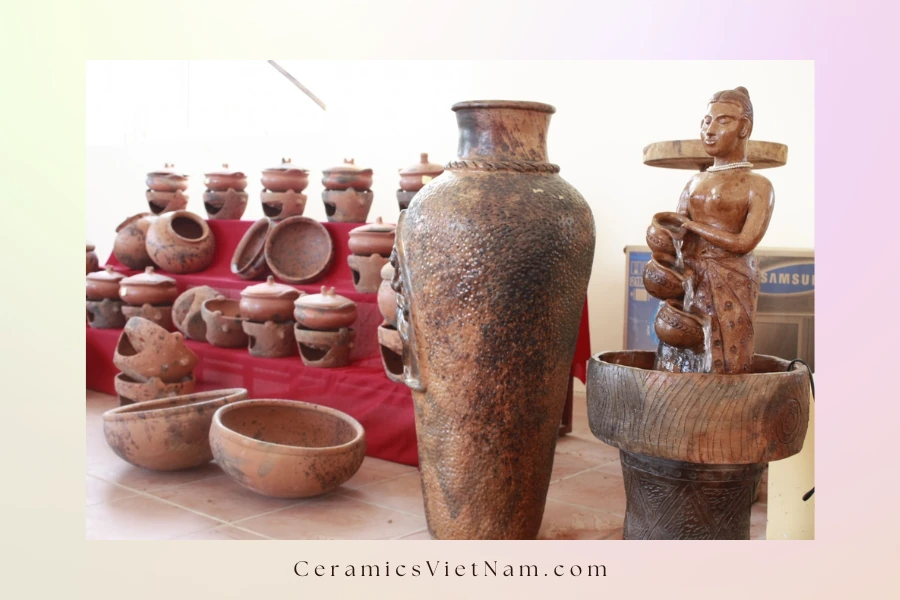
Ceramics of Champa – New position and new opportunities
According to the Cultural Heritage Profile by the Cultural Heritage Department under the Ministry of Culture, Sports and Tourism, the history of Cham pottery-making in Binh Thuan lacks comprehensive, clear, and specific documentation. Even the senior ceramic artisans and Cham dignitaries are unaware of the origins of their pottery craft. Ancient Cham inscriptions do not touch upon this issue, and there are no engraved stones or folklore related to the Cham pottery craft within the Cham community.
Traditional pottery holds a significant role in the economic, cultural, and social life of the Cham people. Ceramic items are indispensable in the daily lives of families and in the religious and cultural practices of the Cham community. Cham ceramics are mainly found in two villages, Ligok (Tri Duc, now Binh Duc, Binh Thuan province) and Hamu Crok (Bau Truc, Ninh Thuan province).
When discussing Cham ceramics, the prominent village is Bau Truc, situated in Phuoc Dan town, Ninh Phuoc district, Ninh Thuan province. Recognized as one of the oldest ceramic villages in Southeast Asia, Bau Truc has maintained entirely manual production methods since the late 12th century.
In Binh Thuan province, Cham people in Binh Duc village, Phan Hiep commune, Bac Binh district, continue the pottery craft using traditional techniques passed down through generations.
The entire Cham pottery-making process reflects a distinctive artistic value. What sets apart Cham pottery is that all participants, exclusively women, move in a circular motion around the pottery table instead of rotating the table itself.
Unique art of Cham ceramics
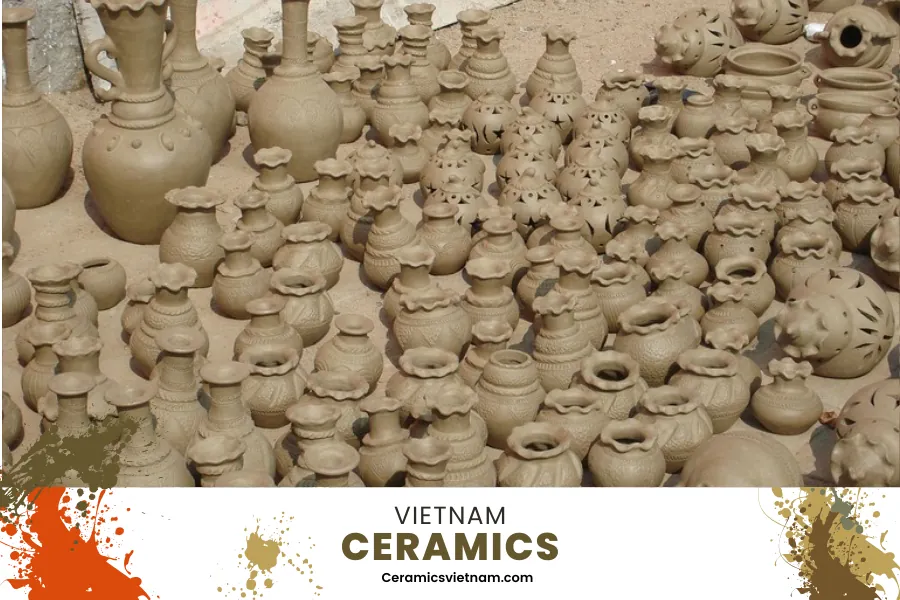
Ceramics of Champa – New position and new opportunities
Bau Truc is the most renowned Cham pottery village in the country. Mentioning Cham ceramics inevitably leads to Bau Truc. The Cham artisans in Bau Truc demonstrate a unique pottery-making art, involving clay selection, mixing, shaping, firing, and decoration.
The raw materials for Bau Truc ceramics include clay, sand, and fresh water, with the clay’s unique adhesive properties being crucial to the distinctiveness of Bau Truc ceramics. This is a vital step in creating the unique features of Bau Truc ceramics.
The clay is soaked in water for about 12 hours before being mixed with sand and fresh water. The mixture is kneaded twice, first using feet and then by hand, to eliminate impurities and achieve the ideal plasticity. This process ensures a careful balance of clay, sand, and fresh water, reflecting the experience of skilled potters.
Subsequently, the shaping process begins without a potter’s wheel. Bau Truc artisans, all women, shape the clay by hand, creating forms without the aid of a rotating table. Simple tools such as a pick, rolled fabric, circular frames, and scraping circles are used for smoothing and thinning the clay body.
Artisans create intricate patterns on the ceramic surface using basic tools such as shell fragments, iron sticks, brushes, and even damaged combs to depict circles, triangles, leaves, or grass. Notably, Bau Truc ceramics avoid depicting animal or human figures due to the belief that doing so is akin to placing such images on the funeral pyres of the Cham Balamon community, who practice cremation.
The final step involves firing the ceramics. Bau Truc ceramics are exposed to open-air firing, requiring careful stacking of fuel materials (wood, straw, and husks) in specific layers. The artisans place the ceramics on top, covering them with a thick layer of straw and a thin layer of husks. A long stick is then used to gently tap the surface, creating a porous layer that tightly bonds with the ceramics.
Firing takes place in the afternoon or under light wind conditions to ensure even and stable temperatures. The direction of the kiln firing opposes the prevailing wind direction to prevent strong gusts that may cause the fuel to burn too quickly, avoiding incomplete firing. This method retains the layer of straw ash, which absorbs and retains heat, contributing to the ceramics’ thorough firing.
For those desiring decoration, natural plant dyes are applied to the ceramics immediately after firing while the kiln is still hot. The artisans use long hooks to retrieve each ceramic piece from the kiln for decorating. If no decoration is needed, the ceramics must cool entirely within the kiln before removal.
The artistic value produced during the firing process lies in the free and random application of colors on the ceramic surface. The resulting hues exhibit a unique, vibrant quality, with variations in color dispersion adding to the distinctiveness of each product.
In comparison to Bau Truc Cham ceramics, those from the Cham village in Binh Duc, Phan Hiep commune, Bac Binh district, are less known but equally unique. The pottery-making process in Binh Duc involves multiple interconnected stages.
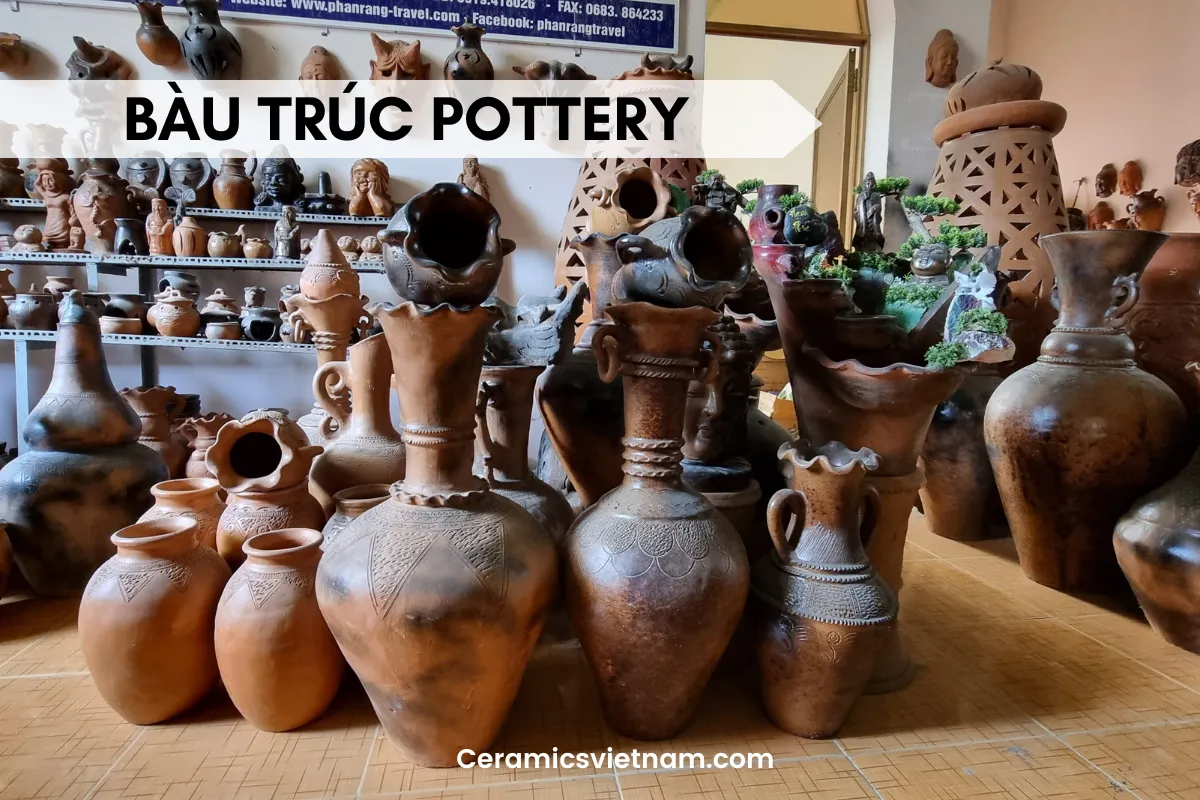
Ceramics of Champa – New position and new opportunities
The first step is selecting and extracting clay. Based on the folklore knowledge of elderly craftsmen, the clay used for pottery must be light yellow, possess moderate plasticity and fineness, and contain minimal impurities. Before 1954, the Cham people of Binh Duc extracted clay for ceramics in Ninh Ha village (now Hoi Ninh, Bac Binh district), about 4 km northeast of Binh Duc. Since 1958, clay mining has shifted to Xuan Quang village, approximately 3 km northwest of Binh Duc. Clay extraction usually occurs during the leisurely agricultural season, around January or February according to the lunar calendar.
Clay workers must process, knead, mix, and compress the clay. The clay treatment before pottery-making determines the quality and performance of the products after firing. To have the finished clay, the artisans mold the pottery products the next morning. The day before, the clay is pounded and mixed; depending on the usage demand, the artisans take an adequate amount of clay, rarely leaving any excess for the next day.
Pottery makers in Binh Duc are also Chăm women, shaping pottery products without using a potter’s wheel, only employing simple tools following traditional manual methods. The tools for shaping pottery products are quite simple: a supporting table (kathun or lithung giơ yơng) and a small piece of coarse fabric. For large and cumbersome pottery products, the process must be performed on a flat surface and is typically carried out by experienced elderly artisans. The artisan spreads a bit of white sand evenly on the supporting table, then places the clay on it to prevent sticking. By bending slightly and moving around the supporting table, the artisan uses both hands to shape the product.
Depending on the type and size of the product, the artisan may add some clay strands to connect and mold the rising body of the product. With the left hand pressing on the inside, the right hand strokes the outer surface of the product, and the artisan moves around the supporting table clockwise about five turns, then reverses direction. This process can create a basic pottery shape. The number of turns depends on the type of product.
Next, the artisan uses a thin bamboo ring to stroke the wet outer surface of the product evenly, then uses a dampened coarse fabric to move in a circular motion, folding and smoothing the mouth of the pottery, making it even and smooth. The inside and outside of the product’s mouth are smoothed with wet fabric. Once the clay has dried, the artisan continues shaping the body and base (adjusting the base to be round with even thickness), scraping, carving, and polishing the inside and outside of the product.
Wet pottery products are left to dry naturally in a shaded area, except for products in kilns, which can be exposed or left in a sunny and windy place. The product’s dryness affects the subsequent shaping process. Shaping and polishing tools are straightforward, such as iron rings, bamboo rings, rattan rings, wooden beating tables, thick iron rings, clamshells, and grinding stones.
Each tool has its function, used according to the size, thickness, and thinness of the pottery bone. For large and thick products, the artisan uses a wide iron ring held in the palm of the hand to polish the inside of the body and base of the product, simultaneously raising the product from the base to the round bottom. For small and thin products, the artisan uses a rattan ring similar in size to the iron ring to raise the base and reduce the thickness of the inside of the body and base of the product.
Then, the artisan uses a wooden ring made of rattan to smooth the inside of the body and base, simultaneously using a beating table to evenly beat the hands on the inside and base to create even, balanced roundness.
Afterward, the artisan polishes and smoothens the outer surface of the product with an iron ring. To check the evenness and balance of the product, the artisan uses clamshells to smooth the inside of the body and base once more, rubbing burnt earthwater onto the entire outer and inner surface of the pottery to create a pink and vibrant color after firing. The product is left in the shade, covered with a plastic sheet to prevent it from drying.
Before firing, the artisan uses a grinding stone to smooth the surface of the product to make the top layer of burnt earthwater on the pottery body. The pottery of the Chăm people is fired uncovered. Typically, a minimum of several hundred products must be fired at once, up to 1,500 to 2,000 products at most. The firing process takes place throughout the year, with many households firing together. The firing time for the entire pottery product can be fast or slow, depending on the quantity of pottery, more or less. If the quantity of pottery is from 1,500-2,000 products, the firing time is about 2 hours; the fewer the pottery products, the faster the firing time.
The artisan must determine the wind direction to arrange the pottery, wood, and other materials reasonably. The firing direction always follows the principle opposite to the direction of the wind. The pottery and wood are arranged horizontally perpendicular to the wind direction to ensure even firing and low cracking rates. The pottery is arranged from small to large, from thick to thin. The main fuel used for firing pottery has been wood and straw. Wood is the main combustion material, while straw absorbs water to cover the top layer of pottery to keep the heat from escaping and to ensure even and faster firing of the pottery.
The firing location must be near a water source to wet the straw covering the pottery to retain heat during firing, cool the bodies of those involved in pottery firing, especially those standing directly burning and taking the fired pottery products outside, and cool the pottery hooks, extinguish the firewood to prevent the fire from spreading. When the fired pottery is taken outside, a type of water made from wild guava or rattan bark is sprinkled on the body of the pottery to create patterns. Therefore, the pottery of Chăm people in Binh Duc has a vibrant pink color, embellished with black stripes resembling a jaguar’s skin on the pottery body.
The pottery products of the Chăm people in Binh Duc are affordable, come in various sizes and types, convenient to use, and are favored by the Chăm community, Vietnamese, Chinese, Raglai, Cơ Ho people, etc., in the region. The products are also consumed in neighboring provinces such as Ninh Thuan, Khanh Hoa, Dong Nai, Lam Dong, and Ho Chi Minh City.
The UNESCO assessment at the 17th session

Ceramics of Champa – New position and new opportunities
The UNESCO assessment at the 17th session of the Intergovernmental Committee for the 2003 Convention on the Safeguarding of the Intangible Cultural Heritage.
The traditional pottery craft of the Chăm people plays a significant role in the economic, cultural, and social aspects of daily life, as well as in the religious practices of Chăm communities. A notable feature of their traditional pottery-making is the technique of crafting without a potter’s wheel, utilizing an open-air firing method (using straw and wood). The unique products bear many historical and cultural imprints of the Chăm ethnic group.
The Chăm people skillfully use their hands to create a diverse range of products that serve both practical and spiritual purposes, reflecting their creative expression and the cultural identity of the Chăm community. These products include water jars, rice containers, decorative screens, reliefs, ornamental lamps, Apsara statues, and Siva statues.
The entire process of pottery-making by the Chăm people embodies a distinctive artistic value. Consequently, despite the various ups and downs in its development, traditional Chăm pottery has withstood the test of time, preserving the essence and pristine beauty of ancient pottery for hundreds of years. This uniqueness and enduring quality constitute the distinctive and lasting value of Chăm pottery.
Keep your job
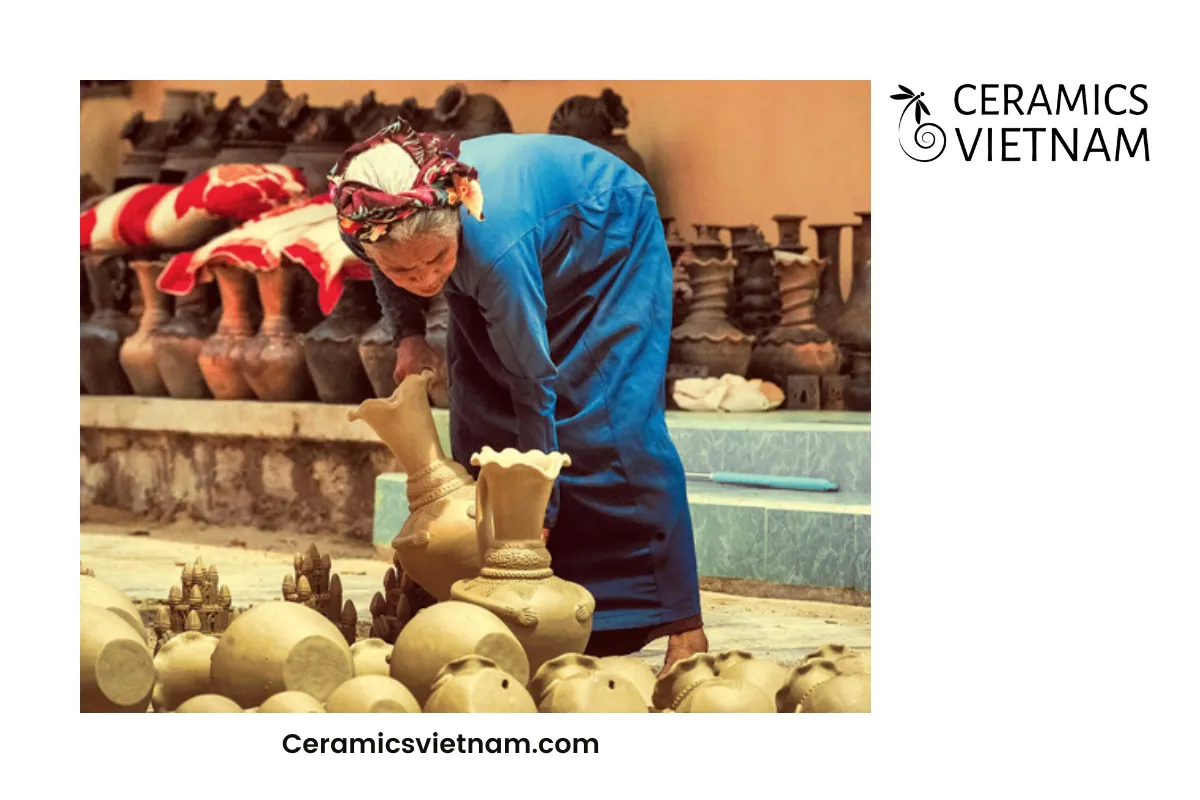
Ceramics of Champa – New position and new opportunities
According to statistics from the Department of Fine Arts, Photography, and Exhibitions, as well as the Bureau of Ethnic Culture (Ministry of Culture, Sports and Tourism), as of 2019, Bau Truc has one cooperative, four limited liability companies, and nine production facilities involving 150 households. Within the village, there is one cooperative, two companies, and 60 pottery production facilities. In the Binh Duc hamlet, by 2021, only 40 households with 44 artisans continue to practice the pottery craft.
The Covid-19 pandemic over the past two years has significantly impacted the Chăm pottery-making households. Currently, Chăm pottery production serves two main purposes: meeting consumer needs and interior decoration. In recent years, the expansion of community tourism to pottery villages, such as Bau Truc, has breathed new life into Chăm pottery.
Today, community tourism development projects have provided additional livelihoods for the locals, generating income through sustainable tourism, environmental protection, preservation, and promotion of the cultural heritage values of the ethnic community. Residents receive support in training skills to serve tourists, including welcoming guests, preparing traditional dishes, and introducing and promoting products. Integrating Chăm pottery into tourism services also encourages young people in pottery villages to embrace the craft and carry on the traditional profession of their ancestors. Notable artisans who remain passionate about Chăm pottery include Đàng Thị Phan, Đàng Thị Vệ, and Đàng Thị Gia.
The documentation of the Chăm pottery heritage by the Cultural Heritage Department indicates a dwindling number of artisans, practitioners, and apprentices in pottery villages. Despite efforts to preserve it, the heritage remains at risk due to various threats such as urbanization affecting the spaces of traditional craft villages, impacting the availability of raw materials, rising costs for materials, skilled artisans aging, lack of interest among the younger generation, a lack of product diversity, and the impact of the Covid-19 pandemic.
To safeguard the heritage from decline due to the influences of modern consumer demands, the documentation also presents a detailed four-year (2023-2026) protection plan. The objectives for each year, specific activities, and expected results are clearly outlined in the documentation. Proposed protective activities aim to address challenges and include training, documentation, addressing issues related to raw materials, and creating sustainable livelihoods for practitioners. The documentation has presented a detailed schedule and budget.
The community, groups, and individuals involved have participated in the nomination process by providing information and contributing to the inventory process. Many community members engaged in the nomination process by providing information, contributing to the inventory process, as well as filming and photographing the pottery-making process and craft worship ceremonies. Furthermore, 354 artisans have given their consent to nominate this heritage for inclusion in the urgent protection list of intangible cultural heritage. The documentation specifies that tourists wishing to participate in craft worship ceremonies must adhere to certain etiquette rules.
Open opportunities for preservation and transmission
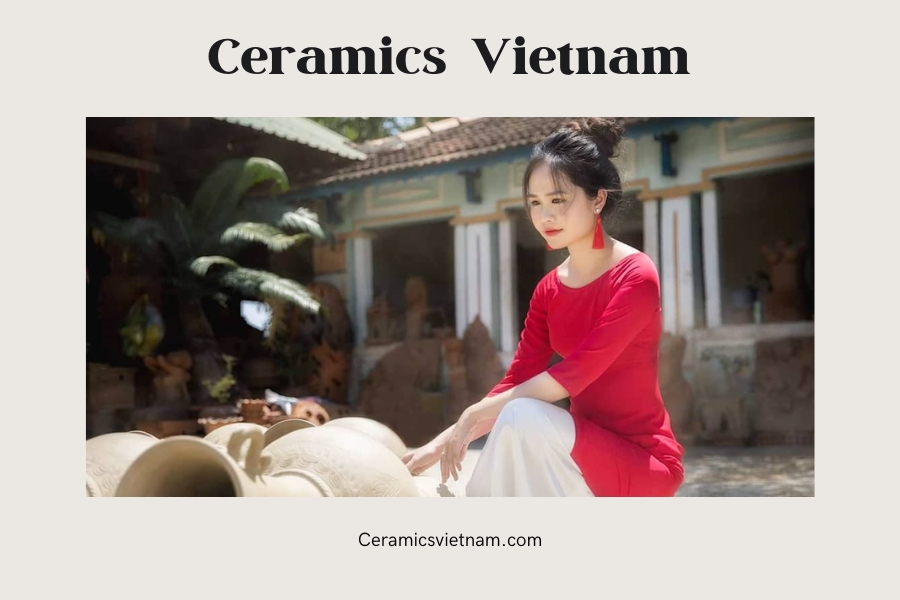
Ceramics of Champa – New position and new opportunities
The Pottery Art of the Chăm People has earned high praise from UNESCO, being recognized for its quality and meeting all five criteria. This achievement is the result of the concerted efforts and close collaboration of the community, provincial authorities of Ninh Thuận and Bình Thuận, with specialized guidance from heritage experts, active and effective leadership from the Ministry of Culture, Sports and Tourism, and the coordinating role of the National UNESCO Committee of Vietnam, the Ministry of Foreign Affairs, and the Permanent Delegation of Vietnam to UNESCO. These efforts encompass proposing, selecting ideas, refining, and mobilizing documentation.
The inscription of Chăm pottery art on the Urgent Safeguarding List of Intangible Cultural Heritage is not only a source of pride for the Chăm community in Ninh Thuận and Bình Thuận but also a shared joy for Vietnam.
This achievement underscores international recognition for Chăm pottery art, acknowledging the cultural values of Vietnam and contributing to enriching the diverse cultural landscape of Vietnam and the world at large.
The recognition of Chăm pottery art as intangible cultural heritage in urgent need of safeguarding also contributes to introducing the cultural essence of ethnic communities, promoting the image of Vietnam as a dynamically developing nation, still rich in tradition and cultural identity.
Chăm pottery being recognized as Urgent Safeguarding Intangible Cultural Heritage also provides additional resources for the preservation and promotion of this heritage, supporting sustainable economic and cultural development at the local and community levels.
This is the 15th intangible cultural heritage of Vietnam recognized by UNESCO, marking another contribution of Vietnam to the goal of preserving and promoting the values of heritage that UNESCO is actively promoting, especially as a member of the Intergovernmental Committee of the 2003 Convention for the 2022-2026 period.
Moreover, this is the fourth title granted to Vietnam by UNESCO this year (alongside the recently inscribed files: “Han-Nom Text in Truong Luu Village, Ha Tinh Province,” “Chewing Betel and Areca Nut in Ngũ Hành Sơn Monument (Da Nang),” and “Cao Lanh Learning City”). This not only reflects the international community’s high regard for the heritage and cultural values of Vietnam but also makes a practical contribution to UNESCO’s efforts in heritage conservation, cultural values promotion, and sustainable development.
Being honored also places responsibility on Vietnam to preserve, promote, inherit, and develop the values of Chăm pottery art.














Leave a reply